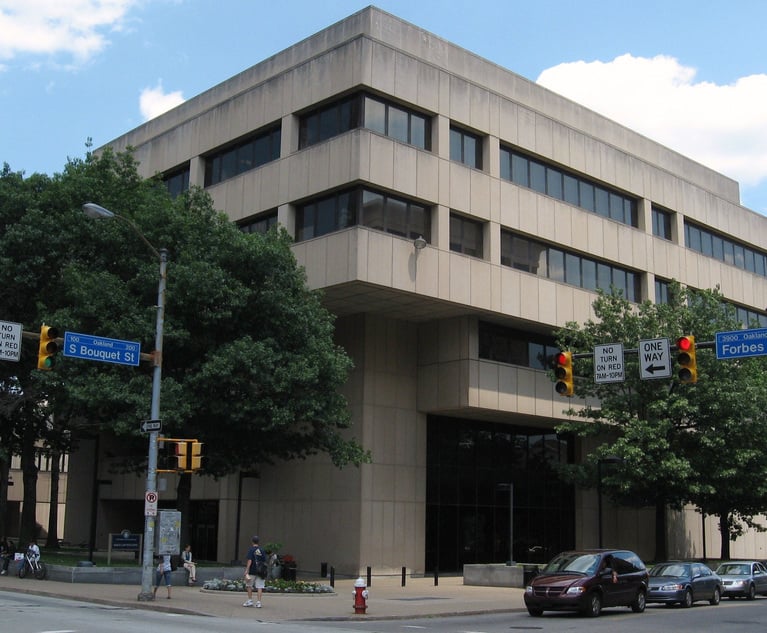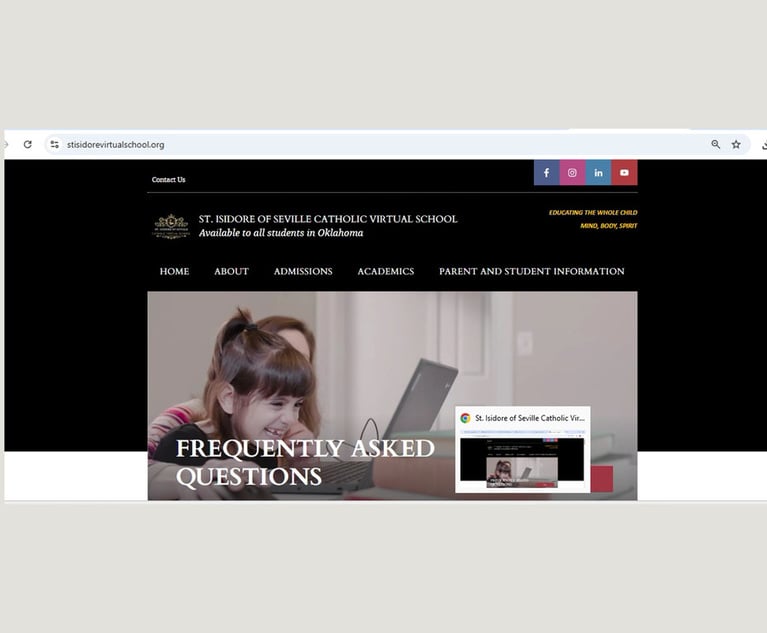Law Deans Implore Federal Judges to Follow Clerk Hiring Plan
"The points they made, I think, are extremely persuasive," said Chief Judge Merrick Garland of the U.S. Court of Appeals for the District of Columbia.
January 29, 2020 at 02:11 PM
6 minute read
 Chief Judge Merrick Garland, U.S. Court of Appeals for the District of Columbia Circuit. (Photo: Diego M. Radzinschi/ALM)
Chief Judge Merrick Garland, U.S. Court of Appeals for the District of Columbia Circuit. (Photo: Diego M. Radzinschi/ALM)
Deans from 11 of the most prestigious law schools in the country have banded together to implore federal judges to participate in a fledgling clerk hiring plan—now entering its second year.
The pilot plan last year helped rein in the clerk hiring chaos that had prevailed since the previous hiring plan fell apart in 2014, the deans wrote in a Jan. 22 letter sent to every judge in the federal judiciary. Pushing hiring back to the end of the second year gave students more time to acclimate to law school life and develop faculty relationships before jumping into the clerk application process, and it provided participating judges with more information about applicants, according to the letter.
It was signed by 11 deans from the top 14 schools as determined by U.S. News & World Report, including those from the law schools at Yale, Stanford and Harvard.
But an unknown number of federal judges have not signed on to the pilot plan and are still hiring on their own timelines—in some cases before the end of the candidate's first year of law school.
That uneven participation has created confusion among students and faculty and put law schools that have opted not to help students apply before the plan's opening date in a difficult position. Ideally, the Judicial Conference—the national policy-making body for the federal courts—would adopt a general clerk hiring policy that adopts the pilot plan's parameters and levels the playing field for all aspiring clerks, the deans argue.
"We all support the pilot as an improvement over the state of affairs that preceded it, and we have taken steps to encourage its adoption as broadly as possible," the letter reads.
It's not clear what impact the deans' letter will have on judges who have thus far declined to hire according to the pilot plan, said Chief Judge Merrick Garland of the U.S. Court of Appeals for the District of Columbia, who is one of the plan's architects, along with Judge Diane Wood of the Seventh Circuit, Judge Sidney Thomas of the Ninth Circuit and Judge Robert Katzmann of the Second Circuit. But a similar 2017 letter from 50 law deans asking for the reestablishment of a federal clerk hiring plan was enough to prompt the introduction of the two-year pilot plan, he noted.
"The points they made, I think, are extremely persuasive," Garland said in an interview this week. "At the time the pilot plan was put into place, hiring was already being done at the end of the first year, and it certainly looked like it would start even earlier. There were some judges who were hiring even before the end of the first year. I think the point of the professors was that this undermined the purpose of the first year of law school."
Garland said he doesn't know whether more judges will participate in the hiring plan when the current cycle starts in June, but he said that most, if not all, of the judges who followed the pilot plan in 2019 will do so again this year. Participation varies, but most judges within the First, Second, Third, Seventh, Ninth and D.C. circuits are on board.
Yale Law School, like most other federal clerkship feeder schools, opted to support the pilot plan by waiting until the opening date to release faculty recommendations to judges. That resulted in a more organized and transparent process last year, said dean Heather Gerken.
"It's always busy, but it was a far better version of busy," Gerken said of last summer's clerk hiring cycle. "Before, the process always broke just before the end of the semester or in the beginning of the summer after students' first year. It used to begin with judge reaching out quietly but not publicly, asking for applications through faculty members they knew. It was everything wrong with the hiring process: It was not transparent; it was not open to everyone."
In addition, it didn't give first-year law students enough time to determine their career goals before being thrown into the stressful federal clerk hiring process, Gerken said.
Moreover, selecting clerks during the 1L year puts first-generation college students and students whose parents aren't lawyers at a disadvantage, since they may not immediately understand the importance of clerkships or developing relationships with faculty members who will recommend them to judges, Garland added. And some students peak academically right away then fade, while others need until their second year to gain their footing, Garland said.
Under the pilot plan, participating judges wait until the end of students' second year to accept clerkship applications. Applications are released at the same time—noon on June 15 this year. Then the judges have a 24-hour reading period to evaluate those applications. The reading period was added this year after getting feedback from judges, Garland said.
"Instead of jumping the moment clerkship applications come in and madly trying to order them, review things and make immediate calls for interviews, we now have a daylong reading period," he said.
When the reading period ends at noon on June 16, judges may call candidates for interviews but must give them 48 hours to accept a clerkship offer. The two-day wait gives students time to interview with other judges or consider the offer.
The pilot plan kicked off in 2019, and the judiciary will circulate a survey among judges after this year's hiring cycle to collect feedback before deciding next steps, Garland said.
The pilot plan is similar to the most recent defunct clerk hiring plan, which was in place for about a decade before formally dissolving in 2014. It started out with strong participation, but judges began abandoning it in 2010 by hiring before the established opening date.
Legal educators and judicial experts have noted that federal judges are a notoriously difficult group to corral, because they have the freedom to run their chambers and hire clerks as they please. But Garland said it's in the best interest of students, law schools and judges to follow the hiring plan.
"The judges who were in the plan the first year have all been very favorable toward it," he said. "The ones who were not in the plan will likely see that, whatever day they hired last year, they will have to hire even earlier this year. Without any starting date, there is really no inherent limitation. I'm hopeful that everyone will see that having this quite simple plan is the best way to go forward."
This content has been archived. It is available through our partners, LexisNexis® and Bloomberg Law.
To view this content, please continue to their sites.
Not a Lexis Subscriber?
Subscribe Now
Not a Bloomberg Law Subscriber?
Subscribe Now
NOT FOR REPRINT
© 2025 ALM Global, LLC, All Rights Reserved. Request academic re-use from www.copyright.com. All other uses, submit a request to [email protected]. For more information visit Asset & Logo Licensing.
You Might Like
View All
LSU General Counsel Quits Amid Fracas Over First Amendment Rights of Law Professor
7 minute read
Pennsylvania Law Schools Are Seeing Double-Digit Boosts in 2025 Applications
5 minute read
What’s at Stake in Supreme Court Case Over Religious Charter School?

University of New Hampshire Law School Launches Specialized Health, Life Sciences Program
Trending Stories
- 1Big Law Partner Co-Launches Startup Aiming to Transform Fund Formation Process
- 2How the Court of Public Opinion Should Factor Into Litigation Strategy
- 3Debevoise Lures Another SDNY Alum, Adding Criminal Division Chief
- 4Cooley Promotes NY Office Leader to Global Litigation Department Chair
- 5What Happens When Lateral Partners’ Guaranteed Compensation Ends?
Who Got The Work
J. Brugh Lower of Gibbons has entered an appearance for industrial equipment supplier Devco Corporation in a pending trademark infringement lawsuit. The suit, accusing the defendant of selling knock-off Graco products, was filed Dec. 18 in New Jersey District Court by Rivkin Radler on behalf of Graco Inc. and Graco Minnesota. The case, assigned to U.S. District Judge Zahid N. Quraishi, is 3:24-cv-11294, Graco Inc. et al v. Devco Corporation.
Who Got The Work
Rebecca Maller-Stein and Kent A. Yalowitz of Arnold & Porter Kaye Scholer have entered their appearances for Hanaco Venture Capital and its executives, Lior Prosor and David Frankel, in a pending securities lawsuit. The action, filed on Dec. 24 in New York Southern District Court by Zell, Aron & Co. on behalf of Goldeneye Advisors, accuses the defendants of negligently and fraudulently managing the plaintiff's $1 million investment. The case, assigned to U.S. District Judge Vernon S. Broderick, is 1:24-cv-09918, Goldeneye Advisors, LLC v. Hanaco Venture Capital, Ltd. et al.
Who Got The Work
Attorneys from A&O Shearman has stepped in as defense counsel for Toronto-Dominion Bank and other defendants in a pending securities class action. The suit, filed Dec. 11 in New York Southern District Court by Bleichmar Fonti & Auld, accuses the defendants of concealing the bank's 'pervasive' deficiencies in regards to its compliance with the Bank Secrecy Act and the quality of its anti-money laundering controls. The case, assigned to U.S. District Judge Arun Subramanian, is 1:24-cv-09445, Gonzalez v. The Toronto-Dominion Bank et al.
Who Got The Work
Crown Castle International, a Pennsylvania company providing shared communications infrastructure, has turned to Luke D. Wolf of Gordon Rees Scully Mansukhani to fend off a pending breach-of-contract lawsuit. The court action, filed Nov. 25 in Michigan Eastern District Court by Hooper Hathaway PC on behalf of The Town Residences LLC, accuses Crown Castle of failing to transfer approximately $30,000 in utility payments from T-Mobile in breach of a roof-top lease and assignment agreement. The case, assigned to U.S. District Judge Susan K. Declercq, is 2:24-cv-13131, The Town Residences LLC v. T-Mobile US, Inc. et al.
Who Got The Work
Wilfred P. Coronato and Daniel M. Schwartz of McCarter & English have stepped in as defense counsel to Electrolux Home Products Inc. in a pending product liability lawsuit. The court action, filed Nov. 26 in New York Eastern District Court by Poulos Lopiccolo PC and Nagel Rice LLP on behalf of David Stern, alleges that the defendant's refrigerators’ drawers and shelving repeatedly break and fall apart within months after purchase. The case, assigned to U.S. District Judge Joan M. Azrack, is 2:24-cv-08204, Stern v. Electrolux Home Products, Inc.
Featured Firms
Law Offices of Gary Martin Hays & Associates, P.C.
(470) 294-1674
Law Offices of Mark E. Salomone
(857) 444-6468
Smith & Hassler
(713) 739-1250








